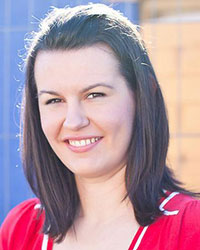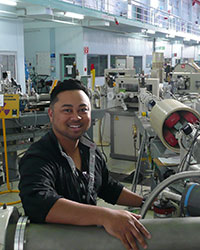EMCR Forum interview with Lidia Matesic and Armand Atanacio
Australian Nuclear Science and Technology Organisation (ANSTO)


What is your current occupation or position?
Lidia: I am a radiochemist at ANSTO in Sydney. As a radiochemist, I work with radioisotopes, particularly fluorine-18, and incorporate them into organic molecules to produce radiolabelled analogues. These can then be used in preclinical studies to image disorders such as cancer and neurological diseases.
Armand: I’m a research and instrument scientist within the Centre for Accelerator Science at ANSTO, also in Sydney. As part of the job I have an Australian Radiation Protection and Nuclear Safety Agency (ARPANSA) licence to operate ANSTO’s 2 million volt particle accelerator known as STAR.
How did you get into the area?
Lidia: After completing my PhD in organic and medicinal chemistry at the University of Wollongong, I started as a Postdoctoral Fellow in organic chemistry at ANSTO. Within a few months, a position for a radiochemist became available and I jumped at the chance to learn a new discipline within chemistry. I was also very excited at the prospect of learning about radiochemistry, since there aren’t many places to do this in Australia.
Armand: I first came to ANSTO in 1999 on a year-in-industry (YII) scholarship as part of my Bachelor of Science (Materials Science) degree at the University of Technology Sydney (UTS). During honours in 2001–02 I had the opportunity to do my experimental work at ANSTO. Fast forward a couple years to 2004 and I came across an ad for a Secondary Ion Mass Spectrometry (SIMS) scientist position at ANSTO. Despite having no previous SIMS experience, I applied and managed to get the job!
In 2006 I took on a PhD part-time, which I completed in 2013. In 2009 my career path at ANSTO took an unexpected turn as the SIMS facility was shut down and I thought I was going to be made redundant. Thankfully I was instead transferred to the Centre for Accelerator Science (CAS) led by Prof David Cohen, where today I perform accelerator-based ion beam analysis (IBA) for internal and external users, as well as my own research.
What do you enjoy most about working in the area?
Lidia: I love working within a niche field of chemistry and using cutting edge instrumentation that is unique in Australia. I also really enjoy being able to work with fellow scientists to see radiolabelled molecules in preclinical studies; to be able to visualise the biological effects of these molecules in the body. Additionally, I really enjoy working with collaborators from Australian and international universities; it’s a privilege to be involved in their research projects.
Armand: I really enjoy the dual-role nature of my position. On one hand I am an instrument scientist, which involves interacting with internal and external users and analysing their samples. The diversity of the samples that come across my desk can span from archaeology through to zoology (and everything in between), so it is always really interesting finding out what users are researching and what they hope its impact will be.
On the other hand I am a research scientist—where I am able to develop my two research interests in the area of photocatalytic oxide materials research and fine particle air pollution research. Having a paper accepted for publication in an international peer-reviewed journal is still a massive buzz for me! I also really enjoy the travel opportunities that come with conferences or my involvement in collaborative International Atomic Energy Agency (IAEA) projects. Even just last year I was at meetings in South Africa, Republic of Korea, New Zealand and the Philippines.
What are the most challenging aspects about your job?
Lidia: The most challenging aspect of my work stems from the short half-life of fluorine-18: 110 min. You need to be very organised and work quickly. You need to know in advance which reactions you will be performing and have all the chemical reagents and solutions ready before the cyclotron delivers the radioactivity. This can be difficult at times since I don’t know which reactions I want to perform until I have already had a few results!
It’s also very important to plan ahead, as the cyclotron can’t produce radioactivity on demand due to my colleagues also requiring a separate batch of radioactivity, so you need to be able to work around other people’s schedules as well. As with all chemical reactions, it’s also very challenging when molecules are stubborn and radiochemical reactions don’t work.
Armand: Whether writing commercial reports, peer-reviewed journal papers or giving an oral presentation at an international conference, communicating scientific results to the wider scientific community and other stakeholders is an integral part of my role. Trying to transfer my often chaotic thinking into organised, coherent words on a page or a presentation is a challenge that I’m continually working on improving.
Describe a typical day in your job?
Lidia: As soon as I arrive to work in the morning, I head to the lab where I start to prepare for the day’s experiments. This involves cleaning the automated radiosynthesis equipment with a variety of solvents in preparation for the day ahead. This can take up to 2 hours and is especially important if the equipment was used on the previous day, since chemical residues need to be removed to prevent cross-contamination for radiosynthesis later in the day. I usually don’t clean my equipment on the same day as I use it, to allow for the radioactivity to decay to background levels [Ed.—What an awesome excuse for not cleaning up after yourself]. The majority of the cleaning procedure is automated, meaning that I can grab a coffee and check emails while I wait!
I usually have radioactivity from the in-house cyclotron delivered mid-morning and the next 3-4 hours are spent performing radiochemical reactions. These reactions can be either on a new molecule our group is investigating or a known molecule, where I am trying to improve the radiosynthesis. All of the radiochemical reactions need to be completed within approximately 6 hours due to the short half-life of fluorine-18. However, some reaction analysis can be performed by queueing up samples in analytical instrumentation such as a HPLC system and letting it run overnight. After I complete my experiments, my afternoons are usually spent on administrative tasks, meetings and where possible, writing papers!
Armand: If I am operating the accelerator I tend to come to work early, around 7am, to start it up. It can sometimes take a couple of hours to achieve a focused stable ion beam. If I’m working with a user, we would talk through their requirements and mount their samples. Each sample can take anywhere between 5 minutes to a couple of hours to complete, depending on what needs to be done. Once all the raw data has been collected, I usually head back to my office to analyse the data spectra using specialised software. This can sometimes take even longer than the raw data collection on the accelerator. Finally I prepare the data report and send it to the user.
Other typical days may be taken up by reading journal papers, trying to interpret and understand often unexpected results, drafting or editing (and re-editing…and re-editing) journal papers or reports, email correspondence with current/potential users, collaborators or my PhD students, attending formal project meetings or having informal discussions with colleagues.
Any advice for EMCRs wishing to pursue a career in this area?
Lidia: A solid understanding of organic or inorganic chemistry is beneficial when pursuing a career as a radiochemist. Unfortunately radiochemistry is usually not taught as a topic within chemistry degrees in Australia, so a lot of theoretical and practical concepts are learned through on-the-job training.
Armand: In general I think a research and instrument scientist has to like problem solving, be naturally inquisitive and think outside the box. One of the biggest differences I see with a research career compared with other careers is the time frame and outcomes. As a carpenter or architect, you might spend days or weeks on a project—but at the end of it you walk away with physically tangible outcome, whether it is a beautiful piece of wooden furniture or a design that someone uses to build their house. As a researcher you could spend years or even an entire career working on a problem with largely intangible outcomes, in the form of incremental advances to the larger body of knowledge. For the most part your efforts are unseen, maybe even unappreciated by those outside your field. It takes a certain kind of personality to be satisfied with that.
By far, my biggest advice for EMCRs is to establish mentors in the field you are interested in. I’ve been blessed to have fantastic mentors along the way who have accelerated (pardon the pun) my learning, stretched my thinking, challenged my understanding and connected me with their valuable networks which have opened up opportunities and collaborations that would have taken me many more years to establish on my own.
What excites you about your work?
Lidia: Being able to use instrumentation not currently available anywhere else in Australia is quite exciting! Also, the ability to perform fundamental radiochemistry research into new molecules and radiosynthetic techniques, which one day may have applications in nuclear medicine.
Armand: What’s not exciting about my work?! I get to operate these large pieces of cutting edge scientific equipment known as particle accelerators, I get to work with some of the brightest scientific minds in Australia at ANSTO, I get to interact with researchers and travel all over the world to conferences as part of my job. Most of all—although it sounds very clichéd—I get to play even a small role in pushing back the frontiers of scientific ignorance every time I provide new data for users of the CAS facility or when I make new progress in my own research areas.
How did your PhD or postdoctoral research assist you with this career?
Lidia: My research background in organic and medicinal chemistry was a great advantage when transitioning into radiochemistry. Many reactions in organic chemistry are translatable to radiochemistry; the main difference is working with radioactive atoms. My PhD was also multidisciplinary—a significant portion involved biological work so by working with biologists previously, I was familiar with some biological concepts and was comfortable working with scientists outside of my area of interest.
My PhD and postdoctoral research gave me a thorough understanding of analytical techniques and instruments used in organic chemistry and many of the same techniques and instruments are used in radiochemistry. I also became familiar with writing papers and presenting at conferences during my PhD, which is something I still do.
Armand: My PhD was a melting pot of fantastic experiences that continue to help me in my position today. I gleaned so much from the combined wealth of research experience in my PhD supervisors Professor Janusz Nowotny, Professor Kathryn Prince and Professor Tadeusz Bak. I learnt how to design experiments, how to critically review literature as well as my own results, how to write journal papers, how to effectively present my research at conferences and start developing networks which I am using today.
Finally, on a personal level I learnt how to effectively manage and balance my time. ‘Work-life balance’ was critical in surviving that period where I worked at ANSTO full-time, studied part-time (spending many a very late night at university running experiments after work and on weekends), got married to the love of my life and then became a father to two beautiful girls, all during the course of my PhD.

© 2025 Australian Academy of Science